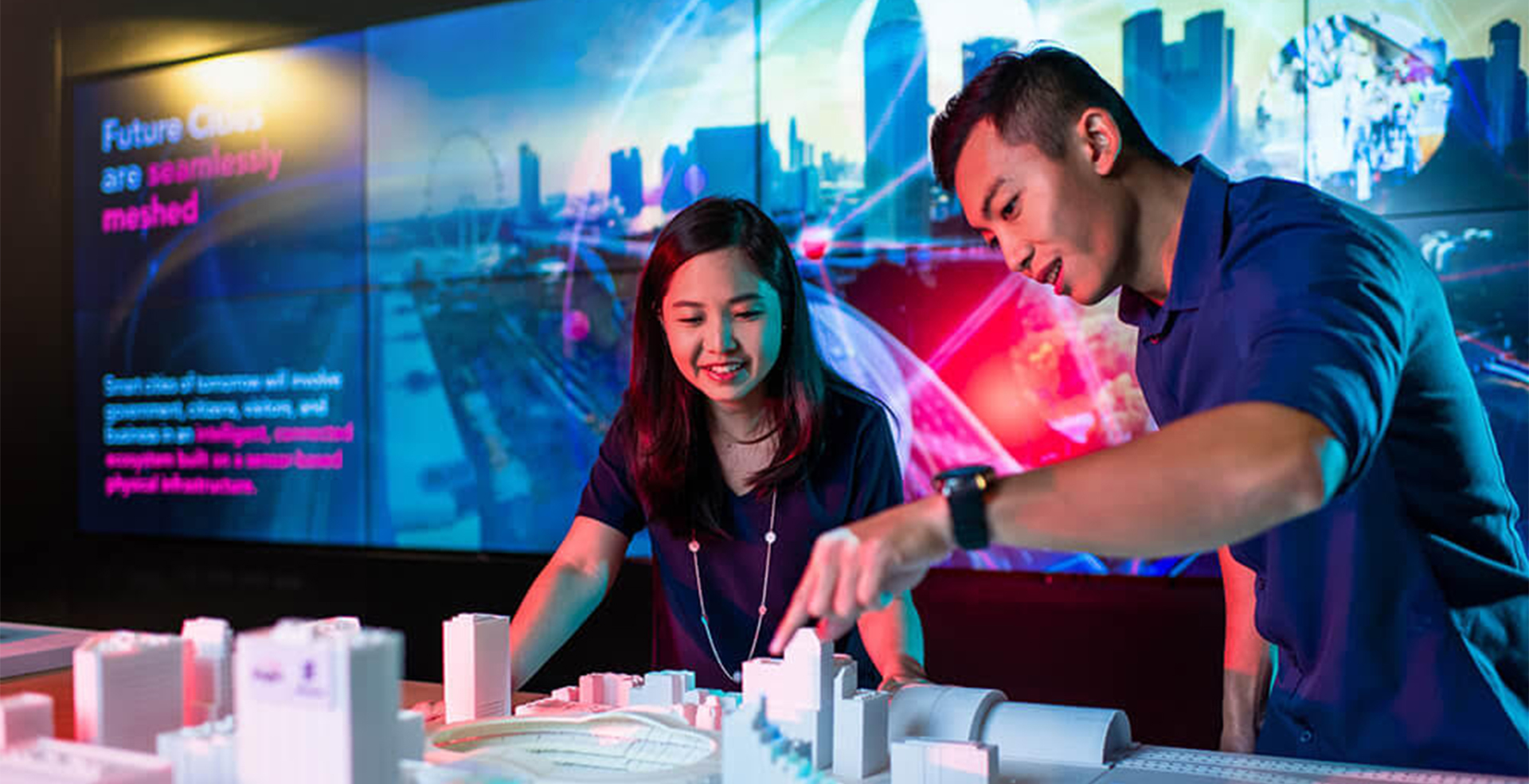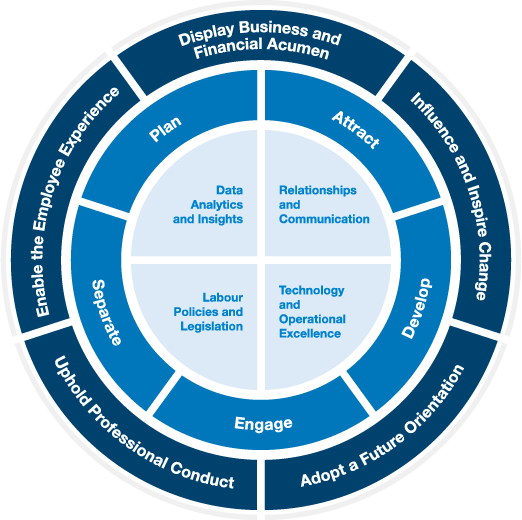
To ensure their businesses stay ahead of the curve, Singtel needs to help their people to adapt even more quickly to new technology needs and changing role requirements.
Singtel’s HR team needed to adopt a ‘Learn More with Less’ approach that could enable businesses to rapidly transform, with a focus on deepening digital capabilities. They also needed their efforts to better equip their teams to be sustainable and demonstrate a clear return on investment.
Singtel’s ‘A.C.T.’ reskilling framework is centred around:

To effectively deploy the ‘A.C.T.’ framework, it is imperative for Chee Keat and his team to have clarity on the future workforce and capability needs across Singtel’s businesses. To build this understanding, the Singtel L&D team uses a ‘capability consulting’ approach to partner with the businesses in workforce planning and design.
This includes working with business leaders to develop the team’s knowledge of key business trends, business strategies and the impact that a range of factors, including technology, will have on the business over the next three to five years.
The team then works in partnership with the business to translate this knowledge into requirements and implications for the future workforce, including organisation design, talent resourcing, capability building, role redesign, and on- and off-shoring decisions. This includes looking at not just emerging skills, but also skills beyond the technology industry and cross-disciplinary skills so that the business can continue to be competitive and innovative.
This in turn informs the development of new future-oriented roles, which may be current roles that will be transformed, or new roles that don’t yet exist. These roles are then mapped onto a role-based competency framework with the relevant competency definitions and expected proficiency levels. This informs a skills-gap analysis to work out which skillsets are required for employees to be ready for these future-oriented roles.
The L&D team uses the new workforce plan and design to inform role design and role transitions.
For example, employees may transition from the existing role of a Store Manager to the new role of a Customer Ops Analyst. As a Store Manager, the employee will have good experience and competencies in face-to-face customer engagement, whilst the new Customer Ops Analyst role will require skills in using data from analytics tools to provide an enhanced customer experience.
The role redesign process takes into consideration how the existing skillsets may be leveraged in the new role of Customer Ops Analyst. The face-to-face customer engagement skills are necessary to add ‘shade and colour’ to the interpretation of the customer behavioural data. When recommending enhancement initiatives in response, the former Store Manager would already have the ‘practical’ context and background to ensure that the initiatives can be implemented effectively.
In addition, the employee would need to be equipped with new skills that are set out in the competency frameworks. These new skills would include proficiency in using analytics tools and creating data visualisations.
Once the competency mapping, skills-gap analysis and role redesign have taken place, the L&D team develops new learning pathways and training plans to enable employees to transition to the new roles. For example, the team may create a new learning pathway to support network engineers to become cybersecurity specialists.
A critical focus area for Chee Keat has been reducing the time taken for employees to be equipped with new skillsets, which enables new capabilities to be deployed across the business more quickly. Singtel’s new digital learning technology platform #CURIOUS is one of the key drivers for this vision for accelerated learning. Since its introduction, the duration for learning pathways has been reduced by 20-40%. For example, a 12-month learning pathway may now take place within 8 months.
The team adopted an employee-centred design approach to their reskilling program, including their digital learning platform #CURIOUS.
The #CURIOUS platform enhances the employee experience by enabling employees to learn at their own pace, access content when it’s needed, and take control of their own learning journey. The content builds technical skill sets, such as certifications for PMP, cloud and cybersecurity, and also supports culture change with content on progressive leadership capabilities, insights from the leadership team and behavioural nudges.
As part of the design process in the development of the #CURIOUS platform, the L&D team conducted an intensive trial of the platform for different employee demographics and segments to understand their learning preferences, user experience, digital adoption behaviours and learning challenges. Armed with these insights, the design for #CURIOUS was then released to targeted groups for 5 months as part of a ‘soft launch’. The team collated and analysed further data on how employees were using the platform, and then tweaked the final design in response before launching it across the whole organisation.
The team also developed a dual employee-centred and business-centred approach to curating the content and channels in #CURIOUS. This included carrying out research to inform the development of different learning personas in Singtel, and the learning interests associated with each persona. The team then curated the content on #CURIOUS to reflect employees’ own interests as well as the capabilities required to help them to perform better in their current roles and prepare them for future roles.
The platform also provides ongoing rapid, real-time feedback and data analytics. This allows the L&D team to continually improve and adapt the program to meet evolving employee needs and respond to their online behaviours.
To help drive change adoption, the L&D team used a consumer-driven communications approach to promoting #CURIOUS, which treats the employee as their key customer. Chee Keat built his team’s communications capability by clearly defining marketing and communications as key progressive competencies for any L&D professional in his team, and by partnering with the Singtel marketing team to learn from their expertise.
The communications activities focus on building learning messages into the flow of employees’ work and life, as well as on testimonies of employees who have benefited from #CURIOUS. This has helped to drive the uptake in learning adoption and eventual role transitions by focusing on the benefits to individual employees in terms of career progression, as well as the need to become ‘future-fit’ to ensure they remain valuable in the talent marketplace.
Gamification is also used to inject fun and energy into the broader #CURIOUS learning experience. For example, the team ran a ‘FAST & #CURIOUS’ competition where employees could earn badges for undertaking learning challenges and compete to win prizes.
Chee Keat says L&D teams will need to transition from a traditional training-focused approach to a ‘capability consulting’ approach that focuses on a deep understanding of the needs of the business rather than just the end deliverables.
What are the future capability challenges we are trying to address?
What is the purpose and impact to the business?
And what is the best intervention?”
He has also identified a need for L&D consultants to build varied business domain expertise, particularly in relation to how different domains intersect. For example, Chee Keat is utilising people with 5G expertise in his team to help Singtel build its full spectrum of 5G capabilities, which includes 5G network infrastructure, product & platform development, sales and marketing, and support. Apart from domain expertise, he is also a strong proponent of equipping his team with cross-disciplinary skills, such as communications, marketing and analytics.
Chee Keat also believes that one of the new frontiers for learning and development will be the ability to more accurately measure the effective application of employees’ capabilities and the impact that these have on the business, rather than relying on proxy measures such as qualifications or completed hours of learning. Whilst this will prove a challenge, this new approach will provide much greater clarity on the true return on investment from equipping people with new capabilities.
Other future challenges will include better supporting leaders and managers to clearly communicate the emerging competencies required for current and future roles, and ensuring employees have the right mindsets to embrace the never-ending journey of equipping themselves for the future.

Singtel’s reskilling program has significantly built up digital and emerging capabilities across its businesses by enabling employees to learn more, faster and at a sustainable cost.
Reskilling journeys and learning pathways have been significantly reduced, which has allowed the new skillsets to be more rapidly deployed across the businesses. For example, the reskilling timeframes for some key roles have been reduced by a third, from 12 months down to 8 months.
The Singtel team drew on a range of IHRP’s competencies, mindsets and behaviours to develop a best practice reskilling approach and create a lasting impact for the business.

